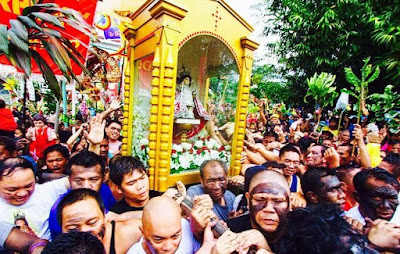Santo Niño de Ibajay - The Miraculous Child of Ibajay, Aklan
 |
| Santo Niño de Ibajay |
 |
| Santo Niño de Ibajay |
The image of Santo Niño de Ibajay depicts the Santo Niño inits traditional princely regalia like those of his contemporaries in Cebu, Aklan, Iloilo, Tondo among others. The Santo Niño has a this rounded face, a quaint smile, expressive eyes, sports a short curly wig, his left hand in a gesture of blessing while his right hand holding a globus cruciger and sports a crown.
The origins
The origins of Santo Niño de Ibajay began sometime in the 15th to 16th century when a fisherman, living in Sitio Cabotos near Barangay Minaa, went fishing in Ibajay River. 'Hangoe' caught nothing except for the piece of wood, which kept on getting into his net. He headed home and placed the piece of wood under the stove before he slept. The next day, his wife asked him about his catch. The fisherman replied that he caught a piece of wood.
 |
| Santo Niño de Ibajay |
Miracles
One day, the priest woke up and found that the Sto. Nino was missing from the altar. After the desperate search for the wooden Sto. Nino, the faithful were annoyed of the incident. On that same day in Sitio Cabotos, the Sto. Nino - his feet soiled and his clothes were full of amorsiko, was inside the house of Hangoe. Afraid that the parishioners might cut off their hands for stealing, the couple returned the wooden statue to the parish priest of Sitio Boboc-an in the afternoon.
By tradition, the devotees painted their faces with black soot, imitated the playful likeness of the Ati to keep the Sto. Nino from leaving the church, coupled with the festive merrymaking with the beating of drums and shouting ‘Viva cay Senor Sto, Nino Viva!’
Several accounts would attest that the Sto. Nino miraculously protected the Ibajay town from the bandits and Moro pirates from invasion. The Holy Child, it was told, prevented the invaders from docking their ships along the shoreline of Ibajay.
 |
| The "Pagsueang" |
The Sto. Niño and the “Sayaw” (a Moro-Moro dance ritual depicting the war between the Christians and the Moros “muslim” in ibajay) The public performance of the “Sayaw “of the Calizo Clan during the feast of the Sto. Nino in Ibajay is a feature of the celebration never done in any other town in Aklan where the feast is also observed, like Kalibo, Makato, Numancia and Altavas.
The festive "Pagsueang" or the enthronement rites the image of the Sto. Nino from the parish rectory to the parish church main altar, done during the vespera of the fiesta, beginning at eleven-thirty in the morning. This ceremony is the ultimate in merry making, with the most boisterouis drum beating, unabated dancing, ati-ati style, primitive shouts of "Viva Senor St. Nino" verberating all over. Devotees would be burst out their emotions whenever the rites took place.
 |
| Santo Niño de Ibajay |
The devotion
The devotion to the Santo Niño de Ibajay is proven to be strong and important to the people of Ibajay. The January festivities of the Santo Niño is one of the much awaited event in the town and devotees from the town and other parts of the country flock his church to seek his help, witness and join the colorful festivities in his honor. From the day he made himself known in Ibajay, the town became his faithful devotees and became part of the everyday lives and culture of the town. If we are going to look at it in the eyes of the faith, we are seeing again the essence of Christ's life on Earth - to live among us to save us from our sins and enjoy Eternal Life with God, Our Father.
Reference:
Santo Niño de Ibajay, Retrieved from Abanteibajay.weebly.com on November 23, 2018.
Special thanks to the administrators of Solid Devotees of Santo Niño de Ibajay for the information and photographs of the miraculous Santo Niño de Ibajay.
+AM+DG+





Comments
Post a Comment